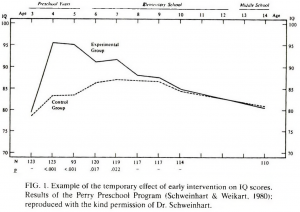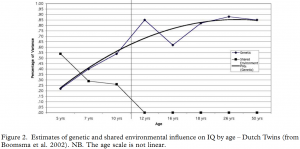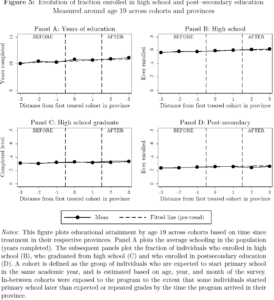https://www.goodreads.com/book/show/17772014-raising-of-intelligence-the
Very useful book. I had read about it in multiple sources. It is a history of attempts to cure the retarded and in general raise intelligence. The answer to the question “how much can we boost intelligence?” is still, as Jensen gave in 1969 (!) “not much”.
—
In 1962 a little-known chemist, Nikolai Fedyakin, working in a small techno
logical institute in an isolated region of Russia, produced from ordinary
water a fluid that had some extraordinary properties (my discussion of this
incident is drawn from Franks’s [1981] fascinating book, Poly water). While
studying liquids sealed in very narrow glass capillaries, Fedyakin discovered
that after a few days a small amount of liquid separated from the rest of the
liquid, and over a period of about a month this secondary column of liquid
grew to about 1.5 mm in length. This new liquid had a higher density than
the presumably pure liquid from which it had spontaneously separated, and
it had other remarkable properties as well.
After Fedyakin had published his finding we hear little more about him.
A well-known Russian scientist, Boris V. Deryagin, took over Fedyakin’s
work and published a number of additional experiments describing this
remarkable new anomalous water, or polywater (a polymerized form of
water), which was said to be a new and more stable form of water; for even
when removed from the capillary tube, polywater continued to exhibit its
peculiar properties and somehow must have retained its unusual molecular
structure. It did not boil at 100°C, solidification did not occur until -3 0 °C ,
and the solid that did form was not ice. One possibility that was repeatedly
raised was that impurities—from the glass capillary, for example—modified
the composition of the water and consequently this was not a new form of
water at all. But Deryagin and others were extremely careful and dismissed
the idea that the results were due to impurities. From 1962 to 1966 Deryagin
and his colleagues published 10 papers, refining their methods and using
quartz capillary tubes to assure the water’s purity.
When in 1966 Deryagin presented his findings to international societies,
scientists outside the Soviet Union began to show greater interest, and
additional mysterious results were reported. One scientist called the find
ings the most important physical-chemical discovery of the century, and
many agreed. A letter published in the prestigious British journal Nature
helped to spread the word, and by 1968 the mass media had been infected,
first in Germany, then in Great Britain and the United States.
The structure of this new form of water was heatedly debated. Confirming
experiments indicated that the spectra of anomalous water were different
than those of ordinary water. The U.S. Office of Naval Research, sensing
an important area of research (think of the military applications), contrib
uted financial support, and many scientists shifted their line of research in
order to study polywater, frequently with support from various federal
granting agencies. In 1969, a publication in Science, the American equiva
lent of Nature, confirmed the existence of this newly found substance, and
spectroscopic analysis gave no evidence for any contamination from the
capillary tubes or by oils or greases. Heated debate and increased activity
ensued, and the Western press hastened to claim American priority for this
revolutionary discovery. A warning was published in Nature that polywater
was extremely dangerous because once it is dispersed in the soil it will be
too late; the more stable poly water will grow at the expense of ordinary
water. In time, all water will be converted into polywater! This in spite of
the fact that by 1969 a great deal of effort had managed to produce only a
few millionths of a gram. Nevertheless, the popular press underscored the
dangers, and entire scientific meetings were given over to the subject.
Elaborate theories were introduced to explain the structure of polywater.
The publication list was substantial. From 1962 to 1974, in the United
States alone there were 115 research publications and 112 popular articles,
comments, and reviews, and there were 285 polywater-related publications
in other countries. The peak years were 1969 to 1972, with a precipitous
decline after that.
Inevitably, the truth won out. In late 1969, in an article in Nature, the
suggestion was again raised that polywater was nothing more than water
contaminated by soluble components of the glass or quartz capillaries
despite the great care taken to keep the water pure. Because there were
never more than a few micrograms of polywater available it was very
difficult to analyze, but a 1970 paper in Science reported that polywater
contained a number of inorganic substances, including 20- to 60% sodium,
as well as potassium, chloride, sulfate, and traces of other elements. An
international conference on polywater was called in 1970, for by now
almost every issue of Science and Nature contained something about
polywater. At the conference, Deryagin maintained that careless work
accounted for the presence of contaminants, but many scientists who had
defended the existence of polywater began to recant. In 1973, Deryagin
finally agreed that the strange properties of anomalous water were due to
impurities rather than to polymeric water molecules.
Very cool story bro. The book is here: https://www.goodreads.com/book/show/4930040-polywater
–
Of the 107 comparisons on Raven’s test, 5 significant differences favored
Follow Through groups, 11 favored non-Follow Through groups, and in 91
there were no reliable differences. It is very clear that experience in Follow
Through programs had no effect on intelligence, as measured by the
Coloured Progressive Matrices Test.
Assessment of the “planned variation” aspect of Project Follow Through
also produced unexpected results. A major goal was to compare the
effectiveness of different educational models, but the results indicated
that differences between sites using the same model were much greater
than differences between the models! Apparently our theories are rela
tively insignificant compared with the practical effects of the inter
action of particular children with particular teachers in particular school
settings.
An analogy of the https://en.wikipedia.org/wiki/Dodo_bird_verdict
The reason for it is the same: the theories these educational ideas were based on were mostly wrong, just like in psychotherapy. If a true theory turns up, it shud have differential validity (just like CBT for psychotherapy).
–
In their follow-up through ages 14 and 15, the project workers obtained
IQs on 89% of the original sample. The results are shown in Figure 1, where
apparently the “waves” have been combined. The IQs at ages 3 to 10 are
derived from the Stanford-Binet, 1960 form, whereas at age 14 they are
from the WISC. These results are typical of the course of IQs in many early
intervention programs: There is a sharp initial rise in IQ for the preschool
children, followed by a gradual decline until there are no longer any
differences between control and experimental groups. Notice that here, as
in the Early Training Project, the experimental/control difference begins to
diminish when the children enter first grade. Differences vanish by age 8.
At age 14, both groups have a mean IQ of about 81, which should be
adjusted upward because the WISC generally measures lower than the
Stanford-Binet, by about 5 IQ points (Flynn, 1984). In view of this, there
would appear to be a leveling off of both groups from around 9 or 10 years
of age.
Good figure to refer to. Compare with the know well known fact that heritability increases with age.
Figure below from:
– Bouchard Jr, Thomas J. “Genetic influence on human intelligence (Spearman’s g): How much?.” Annals of Human Biology 36.5 (2009): 527-544.
–
It is when some psychologists (along with some workers in other disciplines)
leap beyond their data to make exorbitant claims, that the entire field of
psychology is embarrassed. Psychology is not a hard science, although
some areas of psychological research are “harder” than others. Certain
domains of psychology, interested in preventing and improving retarded
intelligence, have received substantial funding, commensurate with the
human importance and difficulty of their mission. But their publications
indicate that, in this area at least, we are still in the dark ages, and dark ages
are ruled by witches and gurus who prove their beliefs by suggestion and
persuasion.
Great quote.


